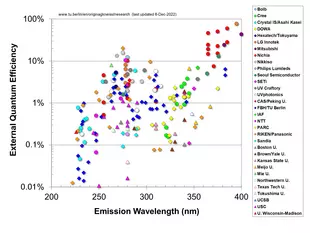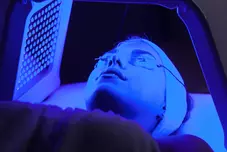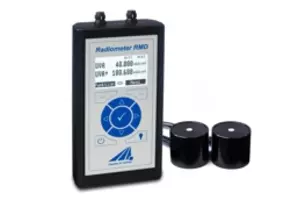UV LEDs for UVA, UVB & UVC
The latest advances in UV LED technology have had a significant impact on various industries, from medical applications and water disinfection to the printing industry. Compared to traditional UV sources such as mercury vapor lamps, UV LEDs offer advantages in terms of environmental friendliness and safety. They contain no mercury, are more energy efficient and have a lower environmental impact.
Due to the European RoHS Directive, there is an urgent need for action to replace lamps containing mercury. The continued use of mercury vapor lamps is currently only possible by invoking exemptions. For example, the entire national and European drinking water industry, which uses UVC for drinking water disinfection, is affected by this. But other industries and applications, such as UV bonding, are also affected.
This article provides a comprehensive insight into the technical specifications and performance data of the latest UV LED systems and compares them with older models. It shows how important the latest developments are for expanding the application possibilities of these technologies.
Production of ultraviolet light-emitting diodes
Electromagnetic radiation is generally generated in III-V semiconductors, i.e. semiconductors made of elements from the third and fifth main groups of the periodic table, whereby the wavelength of the emission peak of UV LEDs is primarily determined by the solid solution composition of the material.
By alloying the semiconductors aluminum nitride (AlN), gallium nitride (GaN) and indium nitride (InN), emission wavelengths in UVA (400 nm - 315 nm), UVB (315 nm - 280 nm) and UVC (280 nm - 200 nm) can be achieved.
The production of UV LEDs involves a number of steps:
Design of the LED heterostructure and chip layout, growth of the substrates and base layers, epitaxy of the semiconductor heterostructure, processing of LED devices at wafer level and finally the separation of the wafers into LED chips and their assembly in packages. UV LEDs therefore consist of many hundreds of semiconductor layers whose composition and doping must be adjusted according to the respective functionality.
The emission wavelength of the LEDs is determined by the composition and doping in which the UV radiation is generated. For all steps, it is important that the electrical power is efficiently converted into optical radiant power. The wall-plug efficiency (WPE) is a particularly important parameter for the application. A key parameter for the application is the overall efficiency, referred to as wall-plug efficiency (WPE). The overall efficiency of UV LEDs indicates the ratio of the optical radiant power to the electrical power supplied.
UVA-emitting UV LEDs now achieve a WPE of around 30-40 %, while blue-emitting LEDs already achieve a very high WPE of around 80 %. In contrast, LEDs with emissions in the low UVB and UVC range have significantly lower WPEs of less than 5% to 10%. For this reason, UVB and UVC LEDs are subject to continuous optimization and technological development. As a result, available LED types have to be replaced by successor types after some time.
Comparison of UV LEDs for UVA, UVB & UVC
Compared to older UV LEDs, the latest UVB and UVC LEDs show significantly higher efficiency and improved performance. Older UV LEDs often suffered from high operating temperatures and rapid degradation, which has been significantly improved by the latest developments. The current generation of UVB and UVC LEDs utilize advanced cooling technologies and improved semiconductor structures and optical couplings that not only extend lifetime but also increase efficiency.
UVB and UVC LEDs do not yet achieve the performance and output of UVA LEDs, but have been able to catch up significantly in recent years.
UVB and UVC LEDs as well as UVA LEDs are manufactured from different substrates and by different epitaxy processes that are specifically tailored to the desired wavelengths and performance requirements. The choice of substrate and epitaxy method has a significant impact on the efficiency, performance and cost of the LEDs.
A technical comparison between UVA LEDs with wavelengths of 365 nm and 385 nm and UVC LEDs with wavelengths of 265 nm, 285 nm and 295 nm is shown below. This table takes into account general parameters such as efficiency, output, service life and typical applications.
| Parameters | UVA LED 365 nm | UVA LED 385 nm | UVC LED 265 nm | UVC LED 285 nm | UVC LED 295 nm |
| Peak wavelength | 365 nm | 385 nm | 265 nm | 285 nm | 295 nm |
| Optical power | 10-1000 mW | 10-1000 mW | 1-30 mW | 1-30 mW | 1-30 mW |
| Efficiency (WPE) | 20-40% | 20-40% | 5-15% | 5-15% | 5-15% |
| Lifetime | Up to 10,000 hours | Up to 10,000 hours | Up to 5,000 hours | Up to 5,000 hours | Up to 5,000 hours |
| Operating temperature | -20°C to +60°C | -20°C to +60°C | -10°C to +50°C | -10°C to +50°C | -10°C to +50°C |
| Typical applications | Hardening, testing | Hardening, testing | Disinfection, sterilization | Disinfection, sterilization | Disinfection, sterilization |
Explanations:
Peak wavelength: The wavelength at which the LED has the highest emission.
Optical power: The total power of the light emitted by the LED in milliwatts.
Efficiency: The ratio of the emitted optical power to the absorbed electrical power.
Lifetime: The expected operating time of the LED up to a point at which the output drops to a certain percentage of its original value, usually 70% (L70).
Operating temperature: The temperature range in which the LED can operate safely and effectively.
Typical applications: The most common applications for the specific LEDs.
These values in the table are general and may vary depending on the manufacturer and specific LED model. It is also important to note that the efficiency and output of UVC LEDs, especially at shorter wavelengths, are typically lower than UVA LEDs.
While UVA LEDs typically have lower aluminum content in the AlGaN layers, UVB and UVC LEDs require higher aluminum content to achieve shorter wavelengths. Epitaxial deposition for UVB and UVC LEDs is technically more demanding due to the higher aluminum content and the associated higher crystal defects. This leads to higher production costs and lower yields.
In addition, the emitted wavelength fluctuates due to the manufacturing process. For this reason, the UV LEDs are spectrally grouped after separation, a process known as binning. It is important to note that the wavelength can change slightly if the LED is replaced from a different batch. With classic lamps, on the other hand, atomic transitions and particle collisions determine the emission. Therefore, the emission does not change with classic lamps.
Applications of UVA LEDs
UVA LEDs with wavelengths in the 315 to 400 nm range are used in numerous technical, scientific and industrial fields, playing a central role in non-destructive testing (NDT) and many other innovative applications.
Non-destructive testing (NDT): UVA LEDs are an important tool in fluorescence testing, a sub-area of NDT. They are used to visualize surface defects or differences in materials by exciting fluorescent dyes that are applied to the parts to be tested. This method is commonly used in the aerospace, automotive and metalworking industries to identify cracks, overlaps, pores and other imperfections.
UV curing: One of the most common applications of UVA LEDs is the UV curing of paints, adhesives and coatings. This technology is used in the printing industry, in the manufacture of electronics (e.g. when bonding smartphone screens) and in the dental industry. UVA LEDs offer the advantage of fast and targeted curing, which shortens process times and increases energy efficiency.
The photoinitiators that have been used in UV curing and UV printing for some time are specially designed to react to the corresponding UVA wavelengths. Additional irradiation with UVB light in the 280 to 300 nm range can improve the curing process.
Medical applications: In dermatology, UVA LEDs are used for phototherapy, particularly for the treatment of skin conditions such as psoriasis and eczema. UVA radiation can help to reduce inflammation and alleviate the symptoms of these diseases.
Plant growth and horticulture: UVA LEDs play a role in agricultural technology, particularly in artificial lighting for plant growth in greenhouses. They can help control certain growth processes and increase plant resistance to pests. Irradiation with UVA causes plants to shorten in length.
Forensic applications: In forensic science, UVA LEDs are used to visualize biological traces such as blood, semen or other bodily fluids. This technique is also used to identify forged documents or banknotes.
Analytical applications: In chemistry and biochemistry, UVA LEDs are used to analyze substances by fluorescence spectroscopy. This method makes it possible to precisely determine the composition and concentration of chemical compounds.
Applications of UVB LEDs
UVB LEDs are increasingly being used in medicine for the treatment of skin diseases such as psoriasis and vitamin D synthesis. Alternatively, excimer lamps or lasers with a wavelength of 308 nm have been used in dermatology for many years. UV LEDs are slowly replacing classic UV lamps. The other applications are therefore:
Vitamin D production: UVB radiation is crucial for the natural production of vitamin D in the skin or food. UVB is used in devices to produce vitamin D, vitamin D2 or previtamin D3. When UVB light with a wavelength between 290 and 315 nm hits the skin, the B-C ring structure of the 7-DHC molecule is broken down. This process is called photolysis.
Unlike humans, who synthesize vitamin D by exposing the skin to UVB radiation, plants do not produce vitamin D in the same way. When fungi and some algae species are exposed to UV radiation, the ergosterol present in their cells can be converted to ergocalciferol (vitamin D2) by a photolytic reaction similar to that which occurs when vitamin D3 is synthesized in human skin. UVB radiation breaks specific bonds in the ergosterol molecule, which leads to its conversion into previtamin D2. Similar to the synthesis of vitamin D3 in humans, the unstable previtamin D2 is converted into the stable vitamin D2 through heat-dependent isomerization.
Tanning: In the cosmetic industry, UVB LEDs and UV lamps can be used in tanning devices to achieve an even and controlled skin tan.
Phototherapy: In medical treatment, UVB is used for phototherapy, particularly for skin conditions such as psoriasis and vitiligo. UVB radiation can help to normalize the overactive skin cells and alleviate the symptoms of these diseases.
Plant cultivation: UVB LEDs also have applications in plant breeding, as UVB light affects the growth, flowering time and secondary metabolites of plants. Irradiation with UVB light can help to increase the production of certain plant constituents such as vitamins, aromas and colorants.
THC production in cannabis: A specific application of UVB LEDs is the optimization of THC production in cannabis. UVB radiation is known to increase stress in plants, which in turn can increase the production of secondary plant compounds such as THC. This is particularly used in legal cannabis growing environments to improve the potency and quality of plants.
Material testing: UVB is used in accelerated aging testing of materials to simulate solar radiation and evaluate the long-term stability of plastics, paints and other materials.
Applications of UVC LEDs
The progressive development of UVC LEDs in terms of efficiency, durability and cost makes them an increasingly attractive option for many areas where mercury vapor lamps have traditionally been used. Therefore, the general applications are:
UV disinfection: one of the most prominent uses of UVC is the disinfection of water, surfaces and air. UVC radiation is highly effective in inactivating bacteria, viruses and other microorganisms, as it damages their DNA or RNA and thus prevents them from reproducing.
UVC LEDs are used in compact water treatment systems to remove pathogenic germs from drinking water at the point of use, i.e. the tap.
Surface disinfection: In hospitals, laboratories and in food processing, portable or permanently installed UVC devices are used that emit UVC radiation to sterilize tools, packaging and work surfaces. Alternatively, UVC lamps are integrated into air conditioning and ventilation systems to clean the air of germs and prevent the spread of disease.
Wound care: UVC LEDs will also be used in medical treatment and wound care in the future, particularly for treating hard-to-heal wounds and infections. The application of UVC light to infected wounds can inhibit the growth of bacterial pathogens and promote healing. It is important to dose the radiation precisely so as not to damage the skin.
Direct photopolymerization: UVC is ideal for photopolymerization, a process in which light-sensitive resins or liquids are cured into solid polymers by irradiation. In additive manufacturing, known as 3D printing, UVC enables the fast and precise curing of photopolymers, resulting in detailed and solid 3D printed objects.
In the manufacture of printed circuit boards and electronic components, UVC light is used to cure adhesives and coatings that are critical for stability and functionality.
Other analytical applications:
UVC LEDs serve as light sources in spectroscopy, where they are used to analyze chemical and biological samples, such as u fluorescence or absorbance measurement in environmental monitoring.
Substrates & epitaxy for UV LEDs:
- UVA LEDs (320 nm to 400 nm):
Sapphire (aluminum oxide) is often used as a substrate as it is inexpensive and readily available. Other substrates such as silicon carbide (SiC) or silicon (Si) are also in use to take advantage of thermal conductivity and compatibility with existing semiconductor manufacturing technologies. The epitaxial layer is deposited by Metal-Organic Chemical Vapor Deposition (MOCVD) and typically consists of aluminum gallium nitride (AlGaN), with the aluminum content being adjusted depending on the desired emission.
- UVB LEDs (280 nm to 320 nm) and UVC LEDs (100 nm to 280 nm)
The same substrates are often used for UVB and UVC LEDs as for UVA LEDs, but the requirements for material quality and purity are higher, especially for the shorter wavelengths in the UVC range. Alternatively, native substrates such as aluminum nitride (AlN) are also used, which enable a better grating match and therefore lower defect densities. AlGaN is also used here as an epitaxial layer, but with a higher aluminum content in order to achieve the shorter wavelengths. The epitaxial layer is also formed using MOCVD, whereby particular attention is paid to the control of defects and the homogeneity of the layer.









